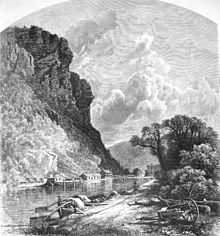John Douglas Woodward

John Douglas Woodward (12 July 1846 – 1924) was an American landscape artist and illustrator described by Joseph Pennell as one of the country's "best-known painters and illustrators". He produced hundreds of scenes of Europe, the Holy Land, and the United States, many of which were reproduced in popular magazines of the day.[1]
Life and work
Early life and training



Woodward was born in Middlesex County, Virginia, the son of John Pitt Lee Woodward and Mary Mildred Minor Woodward, and spent his childhood in Covington, Kentucky, where his father became a successful hardware merchant. By 1861, at the age of 15, he was a pupil of the German painter, Feodor Charles Welsch (1828–1904) in Cincinnati. The family (who had Confederate sympathies) were forced to flee to Canada during the American Civil War, and shortly afterwards, John travelled to New York City where he studied from 1863 to 1865 at the Cooper Union art school and National Academy of Design. He exhibited his first painting at the Academy in 1867.
Initially he tried to earn a living as a landscape artist, taking his inspiration from the countryside of Virginia (his family had settled in Richmond after the war ended in 1865). However, he found it impossible to earn a living from fine art alone and was drawn to book illustration. In 1871, he received his first commission from Hearth and Home magazine, which took him on a sketching tour of the South of the country; these drawings appeared as wood engravings in the magazine.
Career as an illustrator
From 1872-3 he travelled extensively as one of the illustrators for the hugely successful 3-volume Picturesque America series, published by D. Appleton & Company. During this period he came under the influence of Harry Fenn, another important illustrator on the project. Woodward was then employed by the newly established Art Journal (seen as an American version of the London-based The Art Journal), also published by the Appletons. From 1874-5, he was commissioned to produce a series of views of the Hudson River and travelled west on the Transcontinental railroad to San Francisco, drawing scenes that he encountered along the way.
In 1875, Woodward married Maria Louise Simmons. In that year he also produced illustrations for "A Century After: Picturesque Glimpses of Philadelphia". In 1876 he was asked by his publisher to assist Harry Fenn in preparing pictures for a major new work called Picturesque Europe. The project took him to England, Europe, Russia and Scandinavia. For periods between 1877 and 1879 he travelled to the Middle East, with Harry Fenn, working on drawings and watercolours for Picturesque Palestine, Sinai and Egypt.
Return to New York and travels to Europe
In 1879, he returned to New York and spent much of the next three years working further on the illustrations for "Picturesque Palestine". From 1882 he provided illustration for The Century Magazine and several books of poetry, and was now able to devote more time to painting landscapes in oils and watercolors. In 1883 he decided to move to France, with his wife, to further his landscape painting, settling for a short time in Paris, then at Pont-Aven, in Brittany, popular amongst artists, where he remained for a year.
They returned to New York in 1884, and Woodward continued over the coming years to paint pictures and provide illustrations for books (e.g.: Tennyson's Bugle Song [1888] and Charles Kingsley's "Song of the River" [1887]), and journals such as The Century Magazine, Scribner's Magazine and Harper's Monthly. In 1895, a large inheritance after the death of his father gave him the freedom to concentrate wholly on painting.
Between 1898 and 1901, Woodward and his wife traveled to Italy, Switzerland and Capri. In 1905, they settled in [ New Rochelle, New York, a popular art colony among actors, writers and artists of the period where he continued to paint until his death in 1924.[2]
References
- ↑ Rainey, Sue. Drawn to Nature: John Douglas Woodward's Career in Art (Essay from "Resource Library" - 17 Jun 2009).
- ↑ Haverstock, Mary Sayre (2000). Artists in Ohio, 1787-1900: A Biographical Dictionary. Kent State University Press, 2000. p. 967. ISBN 9780873386166.
Further reading
- Rainey, Sue. J.D. Woodward's Wood Engravings of Colorado and the Pacific Railways, 1876-1878 (1993 Journal of the American Historical Print Collectors, Vol. 18, No. 2, pp. 2–12).
- Ackerman, Gerald M. American orientalists (Art Creation Realisation, 1994) pp. 258–65.
- Rainey, Sue & Stein, Roger B. Shaping the Landscape Image, 1865-1910: John Douglas Woodward (University of Virginia Press, 1997).
External links
| Wikimedia Commons has media related to John Douglas Woodward. |
- J D Woodward online (ArtCyclopedia)
- J D Woodward on ArtNet
- Facts about J D Woodward (ArtFact)
|